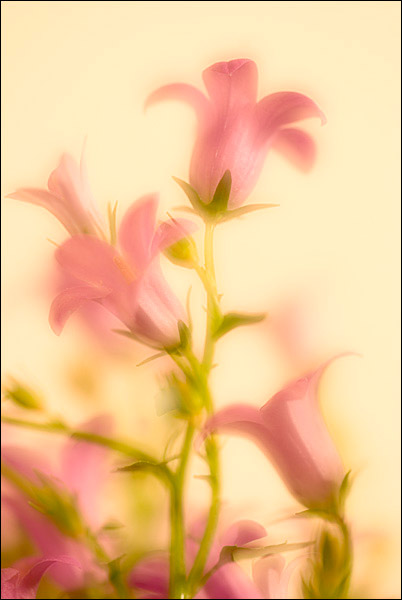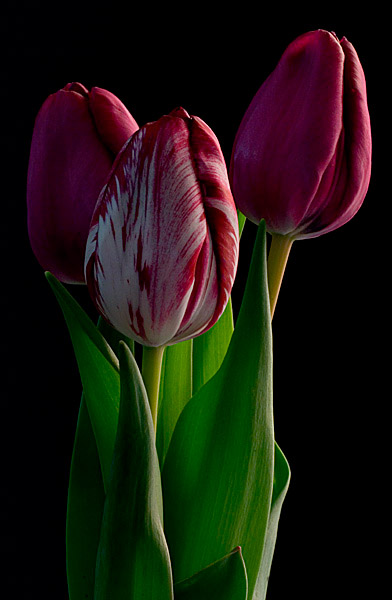Winter is a long and difficult time of year for those of us who like to shoot flowers and plants as subject matter. There are certainly some worthy subjects out there to pursue for those who are adventurous and patient, but for those of us that still prefer to shoot the brighter and more colorful flowers, an indoor photo ‘studio’ is a welcome and necessary tool during these cold months.
I have found that once a subject has been photographed extensively, a photographer might feel that he or she has exhausted the possibilities. One way to add dozens of more photo opportunities to this type of a subject is to change the lighting with which you are shooting the subject. There are many ways to accomplish this. Increasing the light, decreasing the light, backlighting, sidelighting, and using reflected light are just some ideas that come to mind.

I have used mono lights in the past as a light source, although at this time, most of my lighting is done with a set of affordable clamp lights. These work lights that can be bought at about any home improvement store. They are easy to use, can be attached almost anywhere, and being so affordable, more lights can be added without breaking the bank. Most of my clamp lights I purchased for around $10 each.
I have found that 150W to 200W light bulbs work best with the clamp lights as they give off a lot of light. Some of the light bases that I have are only rated to 150W, but I will even use a 200W light as well, as long as I didn't leave them unattended for too long.
There are several different techniques that I will use for floral photos with this lighting setup. I hope to give you some ideas that you can use for lighting your favorite floral subjects.
Reflected Light
This is one of the easiest and most effective techniques to use. The one that I use most often is pointing the lights upward and bouncing the light off the ceiling. This helps to distribute the light evenly, avoiding any harsh shadows. The other day, I was shooting a bunch of tulips and accidentally found that some can lids that we had on one of the shelves in our storage room worked as a great reflector and helped me to get some interesting lighting.

The Low Lighter
Another lighting method that I like to use is where I use very low light. Typically, this is one clamp light placed behind the subject. I may either point the light up at the ceiling or bounce if off the back wall of the room. This allows me to control the amount of light on the subject, as well as where it hits. Usually I use a piece of black foam core as the background. I love to use this method with dark flowers, although it has also worked well with white flowers.
The Complete Poor Man's Studio
So you have decided to try to create yourself a poor man's studio. Just what do you need? Here is the basic list:
- Clamp lights with bulbs.
- Power strip to plug the lights into (I find that I like to have one central point to turn all of my lights on or off).
- Extension cords to get the lights where you want them.
- Small Table (I use a plastic table with fold-in legs from Costco. Any desk or card table would work).
- Vases to hold your subject.
- Plamp, or spring loaded clamp (I use a plamp to sometimes turn the flower just how I want it. You can buy those in the NPN shop).
- Straws (I use these to help me to hold the stems so that I do not crush them with the plamp head).
- Backgrounds (these can be anything, I use black foam core and white foam core since they can be easily changed out).
- You need something to clamp your clamp lights to.
Of course, some of these things you can improvise with - or do without - to make the studio more affordable.
Enjoy the light - I know I do!
Comments on NPN nature photography articles? Send them to the editor.
Nathan Buck resides in Lehi, Utah with his wife, Charisma, and their three young sons. Nathan is a hobbyist photographer whose other favorite pastime is spending time with his family; he finds that photography allows him to do both. Nathan enjoys shooting a wide range of subjects, with flora being at the top of the list (at least for now, his wife says).